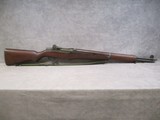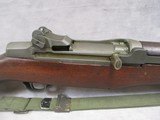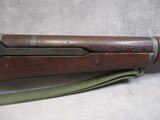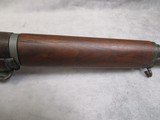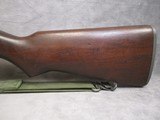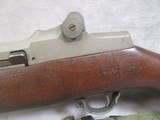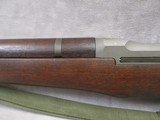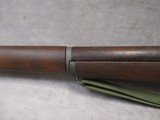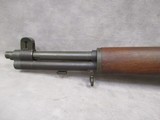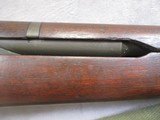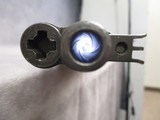Your Session is Ending
 The server has not detected any activity for the last 3 hours.
For your security, your session will expire in 2 minutes and you will be redirected to the Sign In page.
Would you like to stay signed in?
The server has not detected any activity for the last 3 hours.
For your security, your session will expire in 2 minutes and you will be redirected to the Sign In page.
Would you like to stay signed in?
Springfield M1 Garand Made June 1945 Mostly Correct w/CMP Certificate for sale
Springfield M1 Garand Made June 1945 Mostly Correct w/CMP Certificate for sale
Guns International #: 103360362
Seller's Inventory #: 25110159
Springfield M1 Garand Made June 1945 Mostly Correct w/CMP Certificate
Description:
The M1 is one of the most important firearms ever produced by the United States. It served faithfully from World War Two (as the standard issue rifle) all the way into early Vietnam (in the sniper role). This is a Springfield-built M1 (with the CMP Certificate) which features mostly Springfield parts. Almost all original M1 rifles were rebuilt at some point. Virtually any parts matching rifle found today is likely one that has been put together by a collector. Indeed, many collectors will buy multiple rifles and reassemble them with as many parts from one manufacturer as possible. The serial number on the receiver dates it to June of 1945. The barrel was produced by Springfield in March of 1945. Looking down the bore of the rifle, there is no rust or pitting. With a combination muzzle/throat erosion gauge, it has been determined the muzzle tightness is 3.5 while the throat is 2.5. The rifle should still retain a good if not superb level of accuracy. The stock is possibly the original stock as it has all the markings expected with an original Springfield stock. The cartouche is the S.A./NFR (in a box) type, while the large “P” (in a circle) proof stamp is stamped on the front of the pistol grip. It is only a partial stamp though. The bottom of the pistol grip has been stamped with the 0.1875” Ordnance Wheel, which would have been added during a rebuild. The side of the stock has been stamped “A4 AN”, indicating the rebuild was performed at the Anniston Army Depot in Alabama. The front handguard has two scratches, which is shown in the pictures. The stock exhibits minor wear such as dings and dents, but no major cracks. The rear sight cover exhibits some pitting of the surface.
A list of the parts is given at the bottom of the description. Here is a brief description for some of the most important ones. The bolt is of Springfield manufacture. It is stamped “D28287-19SA” which was used on serial numbers 3,300,000 - 3,890,000. It is stamped below “A-8” which is the heat lot number. The hammer is stamped “C46008-7 SA”. These were used on production rifles from May 1943 through August 1944. They were also used in depot-level repair as well, and this is most likely where the rifle received this particular part. The operating rod is marked “D35382 9 SA”. Revision # 9 op rods were built in two ways: one with a curved edge, the other with a straight edge. The former was produced from November ‘43 till January ‘45, and is the most common version. The latter version was introduced in January ‘45 and produced until October ‘45. The rifle here has one of the straight-edge op rods, and it does NOT have a relief cut. Interestingly, the rear sight assembly has the Type 2 Lock Bar. Post World War 2, the M1 Garand was supposed to have whatever sight was installed at the time replaced by the newer T105E1 rear sight. However, due to a shortage of these sights, many M1 Garands retained an older setup. Type 2 lock bar sights are correct for rifles built by Springfield between December of 1942 through to June of 1944 (serial numbers 1 mil - 3 mil). The trigger housing was made by Springfield and is marked “D28290-18-SA”. It was produced between April of 1945 to the end of WW2 production. The safety is also of Springfield manufacture, being stamped with the well-known “SA-11” stamp.
Many people utilize M1 Garands for competition shooting. A word on handloading ammunition for these rifles. Normally, only 150gr bullets should be used in a standard issue M1. This is done to preserve the operating rod. Extensive use of heavy bullets in an unmodified Garand will result in the operating rod bending, meaning the gun will no longer function until the part is replaced. In order to use heavier bullets, a Schuster gas plug must be fitted. If you want to shoot the heavy 220gr round nose ammo, adjust the plug so that the fired cases eject no more than five feet away. If they are ejecting something like twenty feet away, your operating rod is in danger. Hornady .30-caliber 225gr spitzers will usually be too long to fit and require single-loading into the chamber. These gas plugs work well, and I enjoy shooting my personal M1 Garand equipped as such. One important characteristic of the rifle is of course its name. The rifle was named after its inventor, John C. Garand. Today, most people pronounce it “Guh-rand”, the last part coming out like “grand” or “rand” (like Remington-Rand). This is not how Mr. Garand pronounced his own last name. The correct pronunciation is “Gare-rind” with the first part sounding like “dare” (“I dare you to…”) or “bear”, and the second part sounding like “wind” but with the rolling “r” sound instead of the “w”. Most people continue to pronounce the word as many always have (even in WW2) because of tradition but it’s nice to hear the correct pronunciation now and then.
Model: U.S. Rifle, Caliber .30, M1 aka M1 Garand
Serial Number: 3808350
Year of Manufacture: June, 1945 (receiver)
Caliber: .30-06 Springfield aka .30-06, 7.62x63mm
Action: Semi-Automatic, Gas-Piston Operation, Closed Rotating Bolt.
Barrel: Carbon steel, Marked (side): “N 2” (sideways), “3 S A 3 45”, Marked (top): “D35448-34-A-95-B-3” with Ordnance Wheel stamp to the right, then a letter “M” stamp.
Bore: TE = 2.5, Muzzle = 3.5
Barrel Length: 24.0 inches (610 mm)
Rifling: Uniform, 4 grooves, 1:10 inches (1 in 254 mm) RH twist.
Length of Pull: 13.0 inches (330 mm)
Overall Length: 43.5 inches (1105 mm)
Capacity: 8-round en-bloc clip
Receiver: Springfield, Carbon Steel, Marked: “D28291 35”, as well as “Z 2 A”
Finish: Parkerized
Stock: Wood, storage space in butt, metal butt plate with flip open cover
Forearm: Wood
Cartouche: S.A./NFR
Rebuild Stamp: A4 AN (Anniston Army Depot in Alabama)
Other Stock Markings: Ordnance Wheel 0.5-inch (12.7 mm) next to cartouche; smaller Ordnance Wheel 0.1875-inch (4.76 mm) on bottom of pistol grip (rebuild stamp); partial P proof stamp on pistol grip.
Sights: Type 2 Lock Bar rear sight assembly, blade front sight, Sight Radius 27.75 inches (705 mm).
Aperture: Angle cut, grooves, unmarked
Cover: Unmarked
Base: Angled inside corner, unmarked (Springfield)
Pinion: Long Pinion, long splines with cut
Windage Knob: Closed arrows
Elevation Knob: Closed Arrows
Scope: None
Bolt: Springfield, Marked “D28287-19SA” and “A-8”, s/n’s 3,300,000 - 3,890,000 or March ‘44 - end of WWII.
Operating Rod: Springfield, Marked “D35382 9 SA”, Flat side, Jan. ‘45 - Oct. ‘45.
Bullet Guide: Late (stamped), wide slot, fold-over top, 2 punch dots, parkerized
Op Rod Catch: Unmarked
Follower: Springfield, #13, used from February ‘45 and on; also used as replacement parts.
Follower Arm: Unmarked, single bevel
Follower Rod: Long fork, one stamp line (HRA)
Lower Band Unmarked, stamped
Clip Latch: Square front
Trigger: Unmarked
Trigger Housing: Springfield, Marked: “D28290-18-SA”, April 1945 to end of WWII production.
Trigger Guard: Unmarked, stamped with milled hook.
Hammer: Springfield, Marked: “C46008-7 SA”, May ‘43 to Aug ‘44, Depot-level repairs
Safety: Springfield, SA-11
Gas Cylinder: Flat top ring, punch mark on bottom of bayonet lug. Seen on s/n’s 2.0M to 3.88M.
Gas Lock: “M” stamp, round top
Gas Plug/Screw: “P” and hexagon (Elastic Shop Nut Co.)
Rifle Caliber: .30-06 Springfield
Manufacturer: Springfield Arsenal
Model: M1 Garand
Serial Number: 3808350
Barrel Length: 24.0 inches (610 mm)
Bore Info: Rifling: Uniform, 4 grooves, 1:10 inches (1 in 254 mm) RH twist.
Ejectors: Auto Ejection
Condition: Good to Excellent
Barrels: Carbon Steel
Barrel Type: Standard
Action: Semi-Automatic, Gas-Piston Operation, Closed Rotating Bolt.
Triggers: See Notes
Stock: See Notes
Fore End: See notes
Butt Pad: Metal plate with trap door
LOP: 13.0 inches (330 mm)
Finish: Parkerized
Weight: 9.0 lbs.
Sights: See notes
Manufacture Date: June 1945
Extras: CMP Certificate
Price: $1,875.00
Description:
The M1 is one of the most important firearms ever produced by the United States. It served faithfully from World War Two (as the standard issue rifle) all the way into early Vietnam (in the sniper role). This is a Springfield-built M1 (with the CMP Certificate) which features mostly Springfield parts. Almost all original M1 rifles were rebuilt at some point. Virtually any parts matching rifle found today is likely one that has been put together by a collector. Indeed, many collectors will buy multiple rifles and reassemble them with as many parts from one manufacturer as possible. The serial number on the receiver dates it to June of 1945. The barrel was produced by Springfield in March of 1945. Looking down the bore of the rifle, there is no rust or pitting. With a combination muzzle/throat erosion gauge, it has been determined the muzzle tightness is 3.5 while the throat is 2.5. The rifle should still retain a good if not superb level of accuracy. The stock is possibly the original stock as it has all the markings expected with an original Springfield stock. The cartouche is the S.A./NFR (in a box) type, while the large “P” (in a circle) proof stamp is stamped on the front of the pistol grip. It is only a partial stamp though. The bottom of the pistol grip has been stamped with the 0.1875” Ordnance Wheel, which would have been added during a rebuild. The side of the stock has been stamped “A4 AN”, indicating the rebuild was performed at the Anniston Army Depot in Alabama. The front handguard has two scratches, which is shown in the pictures. The stock exhibits minor wear such as dings and dents, but no major cracks. The rear sight cover exhibits some pitting of the surface.
A list of the parts is given at the bottom of the description. Here is a brief description for some of the most important ones. The bolt is of Springfield manufacture. It is stamped “D28287-19SA” which was used on serial numbers 3,300,000 - 3,890,000. It is stamped below “A-8” which is the heat lot number. The hammer is stamped “C46008-7 SA”. These were used on production rifles from May 1943 through August 1944. They were also used in depot-level repair as well, and this is most likely where the rifle received this particular part. The operating rod is marked “D35382 9 SA”. Revision # 9 op rods were built in two ways: one with a curved edge, the other with a straight edge. The former was produced from November ‘43 till January ‘45, and is the most common version. The latter version was introduced in January ‘45 and produced until October ‘45. The rifle here has one of the straight-edge op rods, and it does NOT have a relief cut. Interestingly, the rear sight assembly has the Type 2 Lock Bar. Post World War 2, the M1 Garand was supposed to have whatever sight was installed at the time replaced by the newer T105E1 rear sight. However, due to a shortage of these sights, many M1 Garands retained an older setup. Type 2 lock bar sights are correct for rifles built by Springfield between December of 1942 through to June of 1944 (serial numbers 1 mil - 3 mil). The trigger housing was made by Springfield and is marked “D28290-18-SA”. It was produced between April of 1945 to the end of WW2 production. The safety is also of Springfield manufacture, being stamped with the well-known “SA-11” stamp.
Many people utilize M1 Garands for competition shooting. A word on handloading ammunition for these rifles. Normally, only 150gr bullets should be used in a standard issue M1. This is done to preserve the operating rod. Extensive use of heavy bullets in an unmodified Garand will result in the operating rod bending, meaning the gun will no longer function until the part is replaced. In order to use heavier bullets, a Schuster gas plug must be fitted. If you want to shoot the heavy 220gr round nose ammo, adjust the plug so that the fired cases eject no more than five feet away. If they are ejecting something like twenty feet away, your operating rod is in danger. Hornady .30-caliber 225gr spitzers will usually be too long to fit and require single-loading into the chamber. These gas plugs work well, and I enjoy shooting my personal M1 Garand equipped as such. One important characteristic of the rifle is of course its name. The rifle was named after its inventor, John C. Garand. Today, most people pronounce it “Guh-rand”, the last part coming out like “grand” or “rand” (like Remington-Rand). This is not how Mr. Garand pronounced his own last name. The correct pronunciation is “Gare-rind” with the first part sounding like “dare” (“I dare you to…”) or “bear”, and the second part sounding like “wind” but with the rolling “r” sound instead of the “w”. Most people continue to pronounce the word as many always have (even in WW2) because of tradition but it’s nice to hear the correct pronunciation now and then.
Model: U.S. Rifle, Caliber .30, M1 aka M1 Garand
Serial Number: 3808350
Year of Manufacture: June, 1945 (receiver)
Caliber: .30-06 Springfield aka .30-06, 7.62x63mm
Action: Semi-Automatic, Gas-Piston Operation, Closed Rotating Bolt.
Barrel: Carbon steel, Marked (side): “N 2” (sideways), “3 S A 3 45”, Marked (top): “D35448-34-A-95-B-3” with Ordnance Wheel stamp to the right, then a letter “M” stamp.
Bore: TE = 2.5, Muzzle = 3.5
Barrel Length: 24.0 inches (610 mm)
Rifling: Uniform, 4 grooves, 1:10 inches (1 in 254 mm) RH twist.
Length of Pull: 13.0 inches (330 mm)
Overall Length: 43.5 inches (1105 mm)
Capacity: 8-round en-bloc clip
Receiver: Springfield, Carbon Steel, Marked: “D28291 35”, as well as “Z 2 A”
Finish: Parkerized
Stock: Wood, storage space in butt, metal butt plate with flip open cover
Forearm: Wood
Cartouche: S.A./NFR
Rebuild Stamp: A4 AN (Anniston Army Depot in Alabama)
Other Stock Markings: Ordnance Wheel 0.5-inch (12.7 mm) next to cartouche; smaller Ordnance Wheel 0.1875-inch (4.76 mm) on bottom of pistol grip (rebuild stamp); partial P proof stamp on pistol grip.
Sights: Type 2 Lock Bar rear sight assembly, blade front sight, Sight Radius 27.75 inches (705 mm).
Aperture: Angle cut, grooves, unmarked
Cover: Unmarked
Base: Angled inside corner, unmarked (Springfield)
Pinion: Long Pinion, long splines with cut
Windage Knob: Closed arrows
Elevation Knob: Closed Arrows
Scope: None
Bolt: Springfield, Marked “D28287-19SA” and “A-8”, s/n’s 3,300,000 - 3,890,000 or March ‘44 - end of WWII.
Operating Rod: Springfield, Marked “D35382 9 SA”, Flat side, Jan. ‘45 - Oct. ‘45.
Bullet Guide: Late (stamped), wide slot, fold-over top, 2 punch dots, parkerized
Op Rod Catch: Unmarked
Follower: Springfield, #13, used from February ‘45 and on; also used as replacement parts.
Follower Arm: Unmarked, single bevel
Follower Rod: Long fork, one stamp line (HRA)
Lower Band Unmarked, stamped
Clip Latch: Square front
Trigger: Unmarked
Trigger Housing: Springfield, Marked: “D28290-18-SA”, April 1945 to end of WWII production.
Trigger Guard: Unmarked, stamped with milled hook.
Hammer: Springfield, Marked: “C46008-7 SA”, May ‘43 to Aug ‘44, Depot-level repairs
Safety: Springfield, SA-11
Gas Cylinder: Flat top ring, punch mark on bottom of bayonet lug. Seen on s/n’s 2.0M to 3.88M.
Gas Lock: “M” stamp, round top
Gas Plug/Screw: “P” and hexagon (Elastic Shop Nut Co.)
Rifle Caliber: .30-06 Springfield
Manufacturer: Springfield Arsenal
Model: M1 Garand
Serial Number: 3808350
Barrel Length: 24.0 inches (610 mm)
Bore Info: Rifling: Uniform, 4 grooves, 1:10 inches (1 in 254 mm) RH twist.
Ejectors: Auto Ejection
Condition: Good to Excellent
Barrels: Carbon Steel
Barrel Type: Standard
Action: Semi-Automatic, Gas-Piston Operation, Closed Rotating Bolt.
Triggers: See Notes
Stock: See Notes
Fore End: See notes
Butt Pad: Metal plate with trap door
LOP: 13.0 inches (330 mm)
Finish: Parkerized
Weight: 9.0 lbs.
Sights: See notes
Manufacture Date: June 1945
Extras: CMP Certificate
Price: $1,875.00
Contact Seller
Guns International #: 103360362
Seller's Inventory #: 25110159
Springfield M1 Garand Made June 1945 Mostly Correct w/CMP Certificate
Description:
The M1 is one of the most important firearms ever produced by the United States. It served faithfully from World War Two (as the standard issue rifle) all the way into early Vietnam (in the sniper role). This is a Springfield-built M1 (with the CMP Certificate) which features mostly Springfield parts. Almost all original M1 rifles were rebuilt at some point. Virtually any parts matching rifle found today is likely one that has been put together by a collector. Indeed, many collectors will buy multiple rifles and reassemble them with as many parts from one manufacturer as possible. The serial number on the receiver dates it to June of 1945. The barrel was produced by Springfield in March of 1945. Looking down the bore of the rifle, there is no rust or pitting. With a combination muzzle/throat erosion gauge, it has been determined the muzzle tightness is 3.5 while the throat is 2.5. The rifle should still retain a good if not superb level of accuracy. The stock is possibly the original stock as it has all the markings expected with an original Springfield stock. The cartouche is the S.A./NFR (in a box) type, while the large “P” (in a circle) proof stamp is stamped on the front of the pistol grip. It is only a partial stamp though. The bottom of the pistol grip has been stamped with the 0.1875” Ordnance Wheel, which would have been added during a rebuild. The side of the stock has been stamped “A4 AN”, indicating the rebuild was performed at the Anniston Army Depot in Alabama. The front handguard has two scratches, which is shown in the pictures. The stock exhibits minor wear such as dings and dents, but no major cracks. The rear sight cover exhibits some pitting of the surface.
A list of the parts is given at the bottom of the description. Here is a brief description for some of the most important ones. The bolt is of Springfield manufacture. It is stamped “D28287-19SA” which was used on serial numbers 3,300,000 - 3,890,000. It is stamped below “A-8” which is the heat lot number. The hammer is stamped “C46008-7 SA”. These were used on production rifles from May 1943 through August 1944. They were also used in depot-level repair as well, and this is most likely where the rifle received this particular part. The operating rod is marked “D35382 9 SA”. Revision # 9 op rods were built in two ways: one with a curved edge, the other with a straight edge. The former was produced from November ‘43 till January ‘45, and is the most common version. The latter version was introduced in January ‘45 and produced until October ‘45. The rifle here has one of the straight-edge op rods, and it does NOT have a relief cut. Interestingly, the rear sight assembly has the Type 2 Lock Bar. Post World War 2, the M1 Garand was supposed to have whatever sight was installed at the time replaced by the newer T105E1 rear sight. However, due to a shortage of these sights, many M1 Garands retained an older setup. Type 2 lock bar sights are correct for rifles built by Springfield between December of 1942 through to June of 1944 (serial numbers 1 mil - 3 mil). The trigger housing was made by Springfield and is marked “D28290-18-SA”. It was produced between April of 1945 to the end of WW2 production. The safety is also of Springfield manufacture, being stamped with the well-known “SA-11” stamp.
Many people utilize M1 Garands for competition shooting. A word on handloading ammunition for these rifles. Normally, only 150gr bullets should be used in a standard issue M1. This is done to preserve the operating rod. Extensive use of heavy bullets in an unmodified Garand will result in the operating rod bending, meaning the gun will no longer function until the part is replaced. In order to use heavier bullets, a Schuster gas plug must be fitted. If you want to shoot the heavy 220gr round nose ammo, adjust the plug so that the fired cases eject no more than five feet away. If they are ejecting something like twenty feet away, your operating rod is in danger. Hornady .30-caliber 225gr spitzers will usually be too long to fit and require single-loading into the chamber. These gas plugs work well, and I enjoy shooting my personal M1 Garand equipped as such. One important characteristic of the rifle is of course its name. The rifle was named after its inventor, John C. Garand. Today, most people pronounce it “Guh-rand”, the last part coming out like “grand” or “rand” (like Remington-Rand). This is not how Mr. Garand pronounced his own last name. The correct pronunciation is “Gare-rind” with the first part sounding like “dare” (“I dare you to…”) or “bear”, and the second part sounding like “wind” but with the rolling “r” sound instead of the “w”. Most people continue to pronounce the word as many always have (even in WW2) because of tradition but it’s nice to hear the correct pronunciation now and then.
Model: U.S. Rifle, Caliber .30, M1 aka M1 Garand
Serial Number: 3808350
Year of Manufacture: June, 1945 (receiver)
Caliber: .30-06 Springfield aka .30-06, 7.62x63mm
Action: Semi-Automatic, Gas-Piston Operation, Closed Rotating Bolt.
Barrel: Carbon steel, Marked (side): “N 2” (sideways), “3 S A 3 45”, Marked (top): “D35448-34-A-95-B-3” with Ordnance Wheel stamp to the right, then a letter “M” stamp.
Bore: TE = 2.5, Muzzle = 3.5
Barrel Length: 24.0 inches (610 mm)
Rifling: Uniform, 4 grooves, 1:10 inches (1 in 254 mm) RH twist.
Length of Pull: 13.0 inches (330 mm)
Overall Length: 43.5 inches (1105 mm)
Capacity: 8-round en-bloc clip
Receiver: Springfield, Carbon Steel, Marked: “D28291 35”, as well as “Z 2 A”
Finish: Parkerized
Stock: Wood, storage space in butt, metal butt plate with flip open cover
Forearm: Wood
Cartouche: S.A./NFR
Rebuild Stamp: A4 AN (Anniston Army Depot in Alabama)
Other Stock Markings: Ordnance Wheel 0.5-inch (12.7 mm) next to cartouche; smaller Ordnance Wheel 0.1875-inch (4.76 mm) on bottom of pistol grip (rebuild stamp); partial P proof stamp on pistol grip.
Sights: Type 2 Lock Bar rear sight assembly, blade front sight, Sight Radius 27.75 inches (705 mm).
Aperture: Angle cut, grooves, unmarked
Cover: Unmarked
Base: Angled inside corner, unmarked (Springfield)
Pinion: Long Pinion, long splines with cut
Windage Knob: Closed arrows
Elevation Knob: Closed Arrows
Scope: None
Bolt: Springfield, Marked “D28287-19SA” and “A-8”, s/n’s 3,300,000 - 3,890,000 or March ‘44 - end of WWII.
Operating Rod: Springfield, Marked “D35382 9 SA”, Flat side, Jan. ‘45 - Oct. ‘45.
Bullet Guide: Late (stamped), wide slot, fold-over top, 2 punch dots, parkerized
Op Rod Catch: Unmarked
Follower: Springfield, #13, used from February ‘45 and on; also used as replacement parts.
Follower Arm: Unmarked, single bevel
Follower Rod: Long fork, one stamp line (HRA)
Lower Band Unmarked, stamped
Clip Latch: Square front
Trigger: Unmarked
Trigger Housing: Springfield, Marked: “D28290-18-SA”, April 1945 to end of WWII production.
Trigger Guard: Unmarked, stamped with milled hook.
Hammer: Springfield, Marked: “C46008-7 SA”, May ‘43 to Aug ‘44, Depot-level repairs
Safety: Springfield, SA-11
Gas Cylinder: Flat top ring, punch mark on bottom of bayonet lug. Seen on s/n’s 2.0M to 3.88M.
Gas Lock: “M” stamp, round top
Gas Plug/Screw: “P” and hexagon (Elastic Shop Nut Co.)
Rifle Caliber: .30-06 Springfield
Manufacturer: Springfield Arsenal
Model: M1 Garand
Serial Number: 3808350
Barrel Length: 24.0 inches (610 mm)
Bore Info: Rifling: Uniform, 4 grooves, 1:10 inches (1 in 254 mm) RH twist.
Ejectors: Auto Ejection
Condition: Good to Excellent
Barrels: Carbon Steel
Barrel Type: Standard
Action: Semi-Automatic, Gas-Piston Operation, Closed Rotating Bolt.
Triggers: See Notes
Stock: See Notes
Fore End: See notes
Butt Pad: Metal plate with trap door
LOP: 13.0 inches (330 mm)
Finish: Parkerized
Weight: 9.0 lbs.
Sights: See notes
Manufacture Date: June 1945
Extras: CMP Certificate
Price: $1,875.00
Description:
The M1 is one of the most important firearms ever produced by the United States. It served faithfully from World War Two (as the standard issue rifle) all the way into early Vietnam (in the sniper role). This is a Springfield-built M1 (with the CMP Certificate) which features mostly Springfield parts. Almost all original M1 rifles were rebuilt at some point. Virtually any parts matching rifle found today is likely one that has been put together by a collector. Indeed, many collectors will buy multiple rifles and reassemble them with as many parts from one manufacturer as possible. The serial number on the receiver dates it to June of 1945. The barrel was produced by Springfield in March of 1945. Looking down the bore of the rifle, there is no rust or pitting. With a combination muzzle/throat erosion gauge, it has been determined the muzzle tightness is 3.5 while the throat is 2.5. The rifle should still retain a good if not superb level of accuracy. The stock is possibly the original stock as it has all the markings expected with an original Springfield stock. The cartouche is the S.A./NFR (in a box) type, while the large “P” (in a circle) proof stamp is stamped on the front of the pistol grip. It is only a partial stamp though. The bottom of the pistol grip has been stamped with the 0.1875” Ordnance Wheel, which would have been added during a rebuild. The side of the stock has been stamped “A4 AN”, indicating the rebuild was performed at the Anniston Army Depot in Alabama. The front handguard has two scratches, which is shown in the pictures. The stock exhibits minor wear such as dings and dents, but no major cracks. The rear sight cover exhibits some pitting of the surface.
A list of the parts is given at the bottom of the description. Here is a brief description for some of the most important ones. The bolt is of Springfield manufacture. It is stamped “D28287-19SA” which was used on serial numbers 3,300,000 - 3,890,000. It is stamped below “A-8” which is the heat lot number. The hammer is stamped “C46008-7 SA”. These were used on production rifles from May 1943 through August 1944. They were also used in depot-level repair as well, and this is most likely where the rifle received this particular part. The operating rod is marked “D35382 9 SA”. Revision # 9 op rods were built in two ways: one with a curved edge, the other with a straight edge. The former was produced from November ‘43 till January ‘45, and is the most common version. The latter version was introduced in January ‘45 and produced until October ‘45. The rifle here has one of the straight-edge op rods, and it does NOT have a relief cut. Interestingly, the rear sight assembly has the Type 2 Lock Bar. Post World War 2, the M1 Garand was supposed to have whatever sight was installed at the time replaced by the newer T105E1 rear sight. However, due to a shortage of these sights, many M1 Garands retained an older setup. Type 2 lock bar sights are correct for rifles built by Springfield between December of 1942 through to June of 1944 (serial numbers 1 mil - 3 mil). The trigger housing was made by Springfield and is marked “D28290-18-SA”. It was produced between April of 1945 to the end of WW2 production. The safety is also of Springfield manufacture, being stamped with the well-known “SA-11” stamp.
Many people utilize M1 Garands for competition shooting. A word on handloading ammunition for these rifles. Normally, only 150gr bullets should be used in a standard issue M1. This is done to preserve the operating rod. Extensive use of heavy bullets in an unmodified Garand will result in the operating rod bending, meaning the gun will no longer function until the part is replaced. In order to use heavier bullets, a Schuster gas plug must be fitted. If you want to shoot the heavy 220gr round nose ammo, adjust the plug so that the fired cases eject no more than five feet away. If they are ejecting something like twenty feet away, your operating rod is in danger. Hornady .30-caliber 225gr spitzers will usually be too long to fit and require single-loading into the chamber. These gas plugs work well, and I enjoy shooting my personal M1 Garand equipped as such. One important characteristic of the rifle is of course its name. The rifle was named after its inventor, John C. Garand. Today, most people pronounce it “Guh-rand”, the last part coming out like “grand” or “rand” (like Remington-Rand). This is not how Mr. Garand pronounced his own last name. The correct pronunciation is “Gare-rind” with the first part sounding like “dare” (“I dare you to…”) or “bear”, and the second part sounding like “wind” but with the rolling “r” sound instead of the “w”. Most people continue to pronounce the word as many always have (even in WW2) because of tradition but it’s nice to hear the correct pronunciation now and then.
Model: U.S. Rifle, Caliber .30, M1 aka M1 Garand
Serial Number: 3808350
Year of Manufacture: June, 1945 (receiver)
Caliber: .30-06 Springfield aka .30-06, 7.62x63mm
Action: Semi-Automatic, Gas-Piston Operation, Closed Rotating Bolt.
Barrel: Carbon steel, Marked (side): “N 2” (sideways), “3 S A 3 45”, Marked (top): “D35448-34-A-95-B-3” with Ordnance Wheel stamp to the right, then a letter “M” stamp.
Bore: TE = 2.5, Muzzle = 3.5
Barrel Length: 24.0 inches (610 mm)
Rifling: Uniform, 4 grooves, 1:10 inches (1 in 254 mm) RH twist.
Length of Pull: 13.0 inches (330 mm)
Overall Length: 43.5 inches (1105 mm)
Capacity: 8-round en-bloc clip
Receiver: Springfield, Carbon Steel, Marked: “D28291 35”, as well as “Z 2 A”
Finish: Parkerized
Stock: Wood, storage space in butt, metal butt plate with flip open cover
Forearm: Wood
Cartouche: S.A./NFR
Rebuild Stamp: A4 AN (Anniston Army Depot in Alabama)
Other Stock Markings: Ordnance Wheel 0.5-inch (12.7 mm) next to cartouche; smaller Ordnance Wheel 0.1875-inch (4.76 mm) on bottom of pistol grip (rebuild stamp); partial P proof stamp on pistol grip.
Sights: Type 2 Lock Bar rear sight assembly, blade front sight, Sight Radius 27.75 inches (705 mm).
Aperture: Angle cut, grooves, unmarked
Cover: Unmarked
Base: Angled inside corner, unmarked (Springfield)
Pinion: Long Pinion, long splines with cut
Windage Knob: Closed arrows
Elevation Knob: Closed Arrows
Scope: None
Bolt: Springfield, Marked “D28287-19SA” and “A-8”, s/n’s 3,300,000 - 3,890,000 or March ‘44 - end of WWII.
Operating Rod: Springfield, Marked “D35382 9 SA”, Flat side, Jan. ‘45 - Oct. ‘45.
Bullet Guide: Late (stamped), wide slot, fold-over top, 2 punch dots, parkerized
Op Rod Catch: Unmarked
Follower: Springfield, #13, used from February ‘45 and on; also used as replacement parts.
Follower Arm: Unmarked, single bevel
Follower Rod: Long fork, one stamp line (HRA)
Lower Band Unmarked, stamped
Clip Latch: Square front
Trigger: Unmarked
Trigger Housing: Springfield, Marked: “D28290-18-SA”, April 1945 to end of WWII production.
Trigger Guard: Unmarked, stamped with milled hook.
Hammer: Springfield, Marked: “C46008-7 SA”, May ‘43 to Aug ‘44, Depot-level repairs
Safety: Springfield, SA-11
Gas Cylinder: Flat top ring, punch mark on bottom of bayonet lug. Seen on s/n’s 2.0M to 3.88M.
Gas Lock: “M” stamp, round top
Gas Plug/Screw: “P” and hexagon (Elastic Shop Nut Co.)
Rifle Caliber: .30-06 Springfield
Manufacturer: Springfield Arsenal
Model: M1 Garand
Serial Number: 3808350
Barrel Length: 24.0 inches (610 mm)
Bore Info: Rifling: Uniform, 4 grooves, 1:10 inches (1 in 254 mm) RH twist.
Ejectors: Auto Ejection
Condition: Good to Excellent
Barrels: Carbon Steel
Barrel Type: Standard
Action: Semi-Automatic, Gas-Piston Operation, Closed Rotating Bolt.
Triggers: See Notes
Stock: See Notes
Fore End: See notes
Butt Pad: Metal plate with trap door
LOP: 13.0 inches (330 mm)
Finish: Parkerized
Weight: 9.0 lbs.
Sights: See notes
Manufacture Date: June 1945
Extras: CMP Certificate
Price: $1,875.00
Guns International #: 103360362
Seller's Inventory #: 25110159


Guns International #: 103360362
Seller's Inventory #: 25110159
Springfield M1 Garand Made June 1945 Mostly Correct w/CMP Certificate
Description:
The M1 is one of the most important firearms ever produced by the United States. It served faithfully from World War Two (as the standard issue rifle) all the way into early Vietnam (in the sniper role). This is a Springfield-built M1 (with the CMP Certificate) which features mostly Springfield parts. Almost all original M1 rifles were rebuilt at some point. Virtually any parts matching rifle found today is likely one that has been put together by a collector. Indeed, many collectors will buy multiple rifles and reassemble them with as many parts from one manufacturer as possible. The serial number on the receiver dates it to June of 1945. The barrel was produced by Springfield in March of 1945. Looking down the bore of the rifle, there is no rust or pitting. With a combination muzzle/throat erosion gauge, it has been determined the muzzle tightness is 3.5 while the throat is 2.5. The rifle should still retain a good if not superb level of accuracy. The stock is possibly the original stock as it has all the markings expected with an original Springfield stock. The cartouche is the S.A./NFR (in a box) type, while the large “P” (in a circle) proof stamp is stamped on the front of the pistol grip. It is only a partial stamp though. The bottom of the pistol grip has been stamped with the 0.1875” Ordnance Wheel, which would have been added during a rebuild. The side of the stock has been stamped “A4 AN”, indicating the rebuild was performed at the Anniston Army Depot in Alabama. The front handguard has two scratches, which is shown in the pictures. The stock exhibits minor wear such as dings and dents, but no major cracks. The rear sight cover exhibits some pitting of the surface.
A list of the parts is given at the bottom of the description. Here is a brief description for some of the most important ones. The bolt is of Springfield manufacture. It is stamped “D28287-19SA” which was used on serial numbers 3,300,000 - 3,890,000. It is stamped below “A-8” which is the heat lot number. The hammer is stamped “C46008-7 SA”. These were used on production rifles from May 1943 through August 1944. They were also used in depot-level repair as well, and this is most likely where the rifle received this particular part. The operating rod is marked “D35382 9 SA”. Revision # 9 op rods were built in two ways: one with a curved edge, the other with a straight edge. The former was produced from November ‘43 till January ‘45, and is the most common version. The latter version was introduced in January ‘45 and produced until October ‘45. The rifle here has one of the straight-edge op rods, and it does NOT have a relief cut. Interestingly, the rear sight assembly has the Type 2 Lock Bar. Post World War 2, the M1 Garand was supposed to have whatever sight was installed at the time replaced by the newer T105E1 rear sight. However, due to a shortage of these sights, many M1 Garands retained an older setup. Type 2 lock bar sights are correct for rifles built by Springfield between December of 1942 through to June of 1944 (serial numbers 1 mil - 3 mil). The trigger housing was made by Springfield and is marked “D28290-18-SA”. It was produced between April of 1945 to the end of WW2 production. The safety is also of Springfield manufacture, being stamped with the well-known “SA-11” stamp.
Many people utilize M1 Garands for competition shooting. A word on handloading ammunition for these rifles. Normally, only 150gr bullets should be used in a standard issue M1. This is done to preserve the operating rod. Extensive use of heavy bullets in an unmodified Garand will result in the operating rod bending, meaning the gun will no longer function until the part is replaced. In order to use heavier bullets, a Schuster gas plug must be fitted. If you want to shoot the heavy 220gr round nose ammo, adjust the plug so that the fired cases eject no more than five feet away. If they are ejecting something like twenty feet away, your operating rod is in danger. Hornady .30-caliber 225gr spitzers will usually be too long to fit and require single-loading into the chamber. These gas plugs work well, and I enjoy shooting my personal M1 Garand equipped as such. One important characteristic of the rifle is of course its name. The rifle was named after its inventor, John C. Garand. Today, most people pronounce it “Guh-rand”, the last part coming out like “grand” or “rand” (like Remington-Rand). This is not how Mr. Garand pronounced his own last name. The correct pronunciation is “Gare-rind” with the first part sounding like “dare” (“I dare you to…”) or “bear”, and the second part sounding like “wind” but with the rolling “r” sound instead of the “w”. Most people continue to pronounce the word as many always have (even in WW2) because of tradition but it’s nice to hear the correct pronunciation now and then.
Model: U.S. Rifle, Caliber .30, M1 aka M1 Garand
Serial Number: 3808350
Year of Manufacture: June, 1945 (receiver)
Caliber: .30-06 Springfield aka .30-06, 7.62x63mm
Action: Semi-Automatic, Gas-Piston Operation, Closed Rotating Bolt.
Barrel: Carbon steel, Marked (side): “N 2” (sideways), “3 S A 3 45”, Marked (top): “D35448-34-A-95-B-3” with Ordnance Wheel stamp to the right, then a letter “M” stamp.
Bore: TE = 2.5, Muzzle = 3.5
Barrel Length: 24.0 inches (610 mm)
Rifling: Uniform, 4 grooves, 1:10 inches (1 in 254 mm) RH twist.
Length of Pull: 13.0 inches (330 mm)
Overall Length: 43.5 inches (1105 mm)
Capacity: 8-round en-bloc clip
Receiver: Springfield, Carbon Steel, Marked: “D28291 35”, as well as “Z 2 A”
Finish: Parkerized
Stock: Wood, storage space in butt, metal butt plate with flip open cover
Forearm: Wood
Cartouche: S.A./NFR
Rebuild Stamp: A4 AN (Anniston Army Depot in Alabama)
Other Stock Markings: Ordnance Wheel 0.5-inch (12.7 mm) next to cartouche; smaller Ordnance Wheel 0.1875-inch (4.76 mm) on bottom of pistol grip (rebuild stamp); partial P proof stamp on pistol grip.
Sights: Type 2 Lock Bar rear sight assembly, blade front sight, Sight Radius 27.75 inches (705 mm).
Aperture: Angle cut, grooves, unmarked
Cover: Unmarked
Base: Angled inside corner, unmarked (Springfield)
Pinion: Long Pinion, long splines with cut
Windage Knob: Closed arrows
Elevation Knob: Closed Arrows
Scope: None
Bolt: Springfield, Marked “D28287-19SA” and “A-8”, s/n’s 3,300,000 - 3,890,000 or March ‘44 - end of WWII.
Operating Rod: Springfield, Marked “D35382 9 SA”, Flat side, Jan. ‘45 - Oct. ‘45.
Bullet Guide: Late (stamped), wide slot, fold-over top, 2 punch dots, parkerized
Op Rod Catch: Unmarked
Follower: Springfield, #13, used from February ‘45 and on; also used as replacement parts.
Follower Arm: Unmarked, single bevel
Follower Rod: Long fork, one stamp line (HRA)
Lower Band Unmarked, stamped
Clip Latch: Square front
Trigger: Unmarked
Trigger Housing: Springfield, Marked: “D28290-18-SA”, April 1945 to end of WWII production.
Trigger Guard: Unmarked, stamped with milled hook.
Hammer: Springfield, Marked: “C46008-7 SA”, May ‘43 to Aug ‘44, Depot-level repairs
Safety: Springfield, SA-11
Gas Cylinder: Flat top ring, punch mark on bottom of bayonet lug. Seen on s/n’s 2.0M to 3.88M.
Gas Lock: “M” stamp, round top
Gas Plug/Screw: “P” and hexagon (Elastic Shop Nut Co.)
Rifle Caliber: .30-06 Springfield
Manufacturer: Springfield Arsenal
Model: M1 Garand
Serial Number: 3808350
Barrel Length: 24.0 inches (610 mm)
Bore Info: Rifling: Uniform, 4 grooves, 1:10 inches (1 in 254 mm) RH twist.
Ejectors: Auto Ejection
Condition: Good to Excellent
Barrels: Carbon Steel
Barrel Type: Standard
Action: Semi-Automatic, Gas-Piston Operation, Closed Rotating Bolt.
Triggers: See Notes
Stock: See Notes
Fore End: See notes
Butt Pad: Metal plate with trap door
LOP: 13.0 inches (330 mm)
Finish: Parkerized
Weight: 9.0 lbs.
Sights: See notes
Manufacture Date: June 1945
Extras: CMP Certificate
Price: $1,875.00
Description:
The M1 is one of the most important firearms ever produced by the United States. It served faithfully from World War Two (as the standard issue rifle) all the way into early Vietnam (in the sniper role). This is a Springfield-built M1 (with the CMP Certificate) which features mostly Springfield parts. Almost all original M1 rifles were rebuilt at some point. Virtually any parts matching rifle found today is likely one that has been put together by a collector. Indeed, many collectors will buy multiple rifles and reassemble them with as many parts from one manufacturer as possible. The serial number on the receiver dates it to June of 1945. The barrel was produced by Springfield in March of 1945. Looking down the bore of the rifle, there is no rust or pitting. With a combination muzzle/throat erosion gauge, it has been determined the muzzle tightness is 3.5 while the throat is 2.5. The rifle should still retain a good if not superb level of accuracy. The stock is possibly the original stock as it has all the markings expected with an original Springfield stock. The cartouche is the S.A./NFR (in a box) type, while the large “P” (in a circle) proof stamp is stamped on the front of the pistol grip. It is only a partial stamp though. The bottom of the pistol grip has been stamped with the 0.1875” Ordnance Wheel, which would have been added during a rebuild. The side of the stock has been stamped “A4 AN”, indicating the rebuild was performed at the Anniston Army Depot in Alabama. The front handguard has two scratches, which is shown in the pictures. The stock exhibits minor wear such as dings and dents, but no major cracks. The rear sight cover exhibits some pitting of the surface.
A list of the parts is given at the bottom of the description. Here is a brief description for some of the most important ones. The bolt is of Springfield manufacture. It is stamped “D28287-19SA” which was used on serial numbers 3,300,000 - 3,890,000. It is stamped below “A-8” which is the heat lot number. The hammer is stamped “C46008-7 SA”. These were used on production rifles from May 1943 through August 1944. They were also used in depot-level repair as well, and this is most likely where the rifle received this particular part. The operating rod is marked “D35382 9 SA”. Revision # 9 op rods were built in two ways: one with a curved edge, the other with a straight edge. The former was produced from November ‘43 till January ‘45, and is the most common version. The latter version was introduced in January ‘45 and produced until October ‘45. The rifle here has one of the straight-edge op rods, and it does NOT have a relief cut. Interestingly, the rear sight assembly has the Type 2 Lock Bar. Post World War 2, the M1 Garand was supposed to have whatever sight was installed at the time replaced by the newer T105E1 rear sight. However, due to a shortage of these sights, many M1 Garands retained an older setup. Type 2 lock bar sights are correct for rifles built by Springfield between December of 1942 through to June of 1944 (serial numbers 1 mil - 3 mil). The trigger housing was made by Springfield and is marked “D28290-18-SA”. It was produced between April of 1945 to the end of WW2 production. The safety is also of Springfield manufacture, being stamped with the well-known “SA-11” stamp.
Many people utilize M1 Garands for competition shooting. A word on handloading ammunition for these rifles. Normally, only 150gr bullets should be used in a standard issue M1. This is done to preserve the operating rod. Extensive use of heavy bullets in an unmodified Garand will result in the operating rod bending, meaning the gun will no longer function until the part is replaced. In order to use heavier bullets, a Schuster gas plug must be fitted. If you want to shoot the heavy 220gr round nose ammo, adjust the plug so that the fired cases eject no more than five feet away. If they are ejecting something like twenty feet away, your operating rod is in danger. Hornady .30-caliber 225gr spitzers will usually be too long to fit and require single-loading into the chamber. These gas plugs work well, and I enjoy shooting my personal M1 Garand equipped as such. One important characteristic of the rifle is of course its name. The rifle was named after its inventor, John C. Garand. Today, most people pronounce it “Guh-rand”, the last part coming out like “grand” or “rand” (like Remington-Rand). This is not how Mr. Garand pronounced his own last name. The correct pronunciation is “Gare-rind” with the first part sounding like “dare” (“I dare you to…”) or “bear”, and the second part sounding like “wind” but with the rolling “r” sound instead of the “w”. Most people continue to pronounce the word as many always have (even in WW2) because of tradition but it’s nice to hear the correct pronunciation now and then.
Model: U.S. Rifle, Caliber .30, M1 aka M1 Garand
Serial Number: 3808350
Year of Manufacture: June, 1945 (receiver)
Caliber: .30-06 Springfield aka .30-06, 7.62x63mm
Action: Semi-Automatic, Gas-Piston Operation, Closed Rotating Bolt.
Barrel: Carbon steel, Marked (side): “N 2” (sideways), “3 S A 3 45”, Marked (top): “D35448-34-A-95-B-3” with Ordnance Wheel stamp to the right, then a letter “M” stamp.
Bore: TE = 2.5, Muzzle = 3.5
Barrel Length: 24.0 inches (610 mm)
Rifling: Uniform, 4 grooves, 1:10 inches (1 in 254 mm) RH twist.
Length of Pull: 13.0 inches (330 mm)
Overall Length: 43.5 inches (1105 mm)
Capacity: 8-round en-bloc clip
Receiver: Springfield, Carbon Steel, Marked: “D28291 35”, as well as “Z 2 A”
Finish: Parkerized
Stock: Wood, storage space in butt, metal butt plate with flip open cover
Forearm: Wood
Cartouche: S.A./NFR
Rebuild Stamp: A4 AN (Anniston Army Depot in Alabama)
Other Stock Markings: Ordnance Wheel 0.5-inch (12.7 mm) next to cartouche; smaller Ordnance Wheel 0.1875-inch (4.76 mm) on bottom of pistol grip (rebuild stamp); partial P proof stamp on pistol grip.
Sights: Type 2 Lock Bar rear sight assembly, blade front sight, Sight Radius 27.75 inches (705 mm).
Aperture: Angle cut, grooves, unmarked
Cover: Unmarked
Base: Angled inside corner, unmarked (Springfield)
Pinion: Long Pinion, long splines with cut
Windage Knob: Closed arrows
Elevation Knob: Closed Arrows
Scope: None
Bolt: Springfield, Marked “D28287-19SA” and “A-8”, s/n’s 3,300,000 - 3,890,000 or March ‘44 - end of WWII.
Operating Rod: Springfield, Marked “D35382 9 SA”, Flat side, Jan. ‘45 - Oct. ‘45.
Bullet Guide: Late (stamped), wide slot, fold-over top, 2 punch dots, parkerized
Op Rod Catch: Unmarked
Follower: Springfield, #13, used from February ‘45 and on; also used as replacement parts.
Follower Arm: Unmarked, single bevel
Follower Rod: Long fork, one stamp line (HRA)
Lower Band Unmarked, stamped
Clip Latch: Square front
Trigger: Unmarked
Trigger Housing: Springfield, Marked: “D28290-18-SA”, April 1945 to end of WWII production.
Trigger Guard: Unmarked, stamped with milled hook.
Hammer: Springfield, Marked: “C46008-7 SA”, May ‘43 to Aug ‘44, Depot-level repairs
Safety: Springfield, SA-11
Gas Cylinder: Flat top ring, punch mark on bottom of bayonet lug. Seen on s/n’s 2.0M to 3.88M.
Gas Lock: “M” stamp, round top
Gas Plug/Screw: “P” and hexagon (Elastic Shop Nut Co.)
Rifle Caliber: .30-06 Springfield
Manufacturer: Springfield Arsenal
Model: M1 Garand
Serial Number: 3808350
Barrel Length: 24.0 inches (610 mm)
Bore Info: Rifling: Uniform, 4 grooves, 1:10 inches (1 in 254 mm) RH twist.
Ejectors: Auto Ejection
Condition: Good to Excellent
Barrels: Carbon Steel
Barrel Type: Standard
Action: Semi-Automatic, Gas-Piston Operation, Closed Rotating Bolt.
Triggers: See Notes
Stock: See Notes
Fore End: See notes
Butt Pad: Metal plate with trap door
LOP: 13.0 inches (330 mm)
Finish: Parkerized
Weight: 9.0 lbs.
Sights: See notes
Manufacture Date: June 1945
Extras: CMP Certificate
Price: $1,875.00
Contact Seller
Buy Now
Guns International Advertising Policy
GunsInternational.com is the #1 Gun Classified website that brings gun buyers and gun brokers or sellers together through classified advertising of guns, gun related items and services for sale online. If you are looking to buy guns online or sell guns online, you have come to the right place. GunsInternational.com gun classifieds currently have over 200,000 guns for sale online by numerous dealers and collectors alike. Guns International makes no representation or warranty as to the accuracy of the information contained in the gun classifieds, gun parts or gun services classifieds listings. Buyers and sellers are required to know and comply with all applicable local, state, federal and international firearm laws.
GunsInternational.com is the #1 Gun Classified website that brings gun buyers and gun brokers or sellers together through classified advertising of guns, gun related items and services for sale online. If you are looking to buy guns online or sell guns online, you have come to the right place. GunsInternational.com gun classifieds currently have over 200,000 guns for sale online by numerous dealers and collectors alike. Guns International makes no representation or warranty as to the accuracy of the information contained in the gun classifieds, gun parts or gun services classifieds listings. Buyers and sellers are required to know and comply with all applicable local, state, federal and international firearm laws.
Listings
Home
New Today
New This Week
Rifles For Sale Online
Shotguns For Sale Online
Handguns For Sale Online
Pistols For Sale Online
Revolvers For Sale Online
NFA
Gun Parts For Sale Online
Services
Home
New Today
New This Week
Rifles For Sale Online
Shotguns For Sale Online
Handguns For Sale Online
Pistols For Sale Online
Revolvers For Sale Online
NFA
Gun Parts For Sale Online
Services
©2006 - 2025 all rights reserved. | Guns International.com | V4.1 ww2



Privacy Policy
User Agreement
FAQs
Contact Us
Careers
©2006 - 2025 all rights reserved.
Guns International.com | V4.1 ww2
Guns International.com | V4.1 ww2

